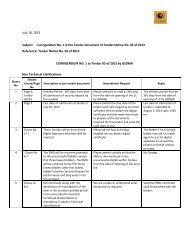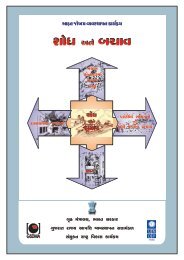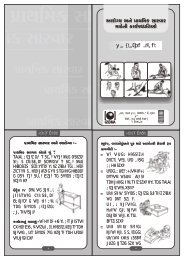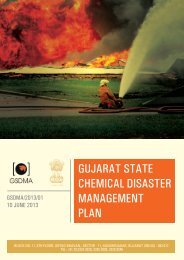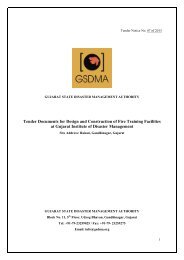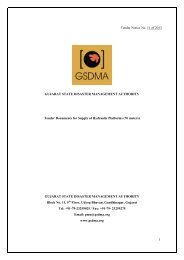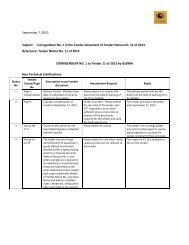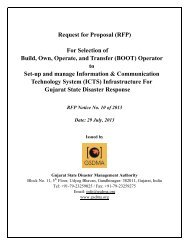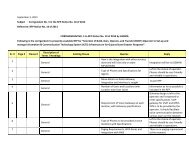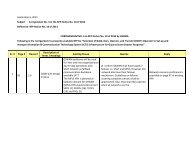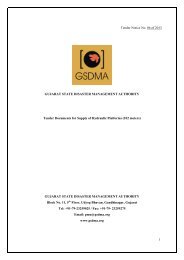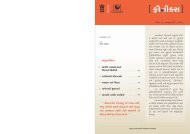Emergency Response Guidebook - Gujarat State Disaster ...
Emergency Response Guidebook - Gujarat State Disaster ...
Emergency Response Guidebook - Gujarat State Disaster ...
Create successful ePaper yourself
Turn your PDF publications into a flip-book with our unique Google optimized e-Paper software.
GUIDE138Substances - Water - Reactive(Emitting Flammable Gases)ERG2012ERG2012Substances - Water-Reactive(Emitting Flammable Gases)GUIDE138POTENTIAL HAZARDSFIRE OR EXPLOSION• Produce flammable gases on contact with water.• May ignite on contact with water or moist air.• Some react vigorously or explosively on contact with water.• May be ignited by heat, sparks or flames.• May re-ignite after fire is extinguished.• Some are transported in highly flammable liquids.• Runoff may create fire or explosion hazard.HEALTH• Inhalation or contact with Vapours, substance or decomposition products may cause severe injury ordeath.• May produce corrosive solutions on contact with water.• Fire will produce irritating, corrosive and/or toxic gases.• Runoff from fire control may cause pollution.PUBLIC SAFETY• CALL EMERGENCY RESPONSE Telephone Number on Shipping Paper first. If Shipping Paper notavailable or no answer, refer to appropriate telephone number listed on the inside back cover.• As an immediate precautionary measure, isolate spill or leak area in all directions for at least 50meters (150 feet) for liquids and at least 25 meters (75 feet) for solids.• Keep unauthorized personnel away.• Stay upwind.• Keep out of low areas.• Ventilate the area before entry.PROTECTIVE CLOTHING• Wear positive pressure self-contained breathing apparatus (SCBA).• Wear chemical protective clothing that is specifically recommended by the manufacturer. It mayprovide little or no thermal protection.• Structural firefighters' protective clothing provides limited protection in fire situations ONLY; it is noteffective in spill situations where direct contact with the substance is possible.EVACUATIONSpill• See Table 1 - Initial Isolation and Protective Action Distances for highlighted materials. Fornonhighlighted materials, increase, in the downwind direction, as necessary, the isolation distanceshown under “PUBLIC SAFETY”.Fire• If tank, rail car or tank truck is involved in a fire, ISOLATE for 800 meters (1/2 mile) in all directions;also, consider initial evacuation for 800 meters (1/2 mile) in all directions.EMERGENCY RESPONSEFIRE• DO NOT USE WATER OR FOAM.Small Fire• Dry chemical, soda ash, lime or sand.Large Fire• DRY sand, dry chemical, soda ash or lime or withdraw from area and let fire burn.• Move containers from fire area if you can do it without risk.Fire Involving Metals or Powders (Aluminum, Lithium, Magnesium, etc.)• Use dry chemical, DRY sand, sodium chloride powder, graphite powder or Met-L-X® powder; inaddition, for Lithium you may use Lith-X® powder or copper powder. Also, see GUIDE 170.Fire involving Tanks or Car/Trailer Loads• Fight fire from maximum distance or use unmanned hose holders or monitor nozzles.• Do not get water inside containers.• Cool containers with flooding quantities of water until well after fire is out.• Withdraw immediately in case of rising sound from venting safety devices or discoloration of tank.• ALWAYS stay away from tanks engulfed in fire.SPILL OR LEAK• ELIMINATE all ignition sources (no smoking, flares, sparks or flames in immediate area).• Do not touch or walk through spilled material.• Stop leak if you can do it without risk.• Use water spray to reduce Vapours or divert Vapour cloud drift. Avoid allowing water runoff tocontact spilled material.DO NOT GET WATER on spilled substance or inside containers.Small Spill• Cover with DRY earth, DRY sand or other non-combustible material followed with plastic sheet tominimize spreading or contact with rain.• Dike for later disposal; do not apply water unless directed to do so.Powder Spill• Cover powder spill with plastic sheet or tarp to minimize spreading and keep powder dry.• DO NOT CLEAN-UP OR DISPOSE OF, EXCEPT UNDER SUPERVISION OF A SPECIALIST.FIRST AID• Move victim to fresh air.• Call 108 or emergency medical service.• Give artificial respiration if victim is not breathing.• Administer oxygen if breathing is difficult.• Remove and isolate contaminated clothing and shoes.• In case of contact with substance, wipe from skin immediately; flush skin or eyes with running waterfor at least 20 minutes.• Keep victim warm and quiet.• Ensure that medical personnel are aware of the material(s) involved and take precautions to protectthemselves.Page 216Page 217



